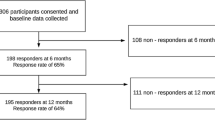Abstract
Improved survival rates of patients with multiple injuries have increased general interest in the quality of rehabilitation status after polytrauma.Due to the complex nature of multiple injuries, a special score is needed to evaluate the outcome after polytrauma.The aim of this study was to validate the Hannover Score for Polytrauma Outcome (HASPOC).One hundred seventy patients who had sustained multiple injuries were re-examined using the HASPOC 2 years after trauma. Results were correlated with the 12-Item Short Form Health Survey (SF-12), a validated and established scoring system.The HASPOC was also correlated with clinical parameters predictive of poor outcome. Two control groups consisting of either patients after single injuries or healthy controls were also evaluated using the HASPOC. In the group of patients after multiple injuries, the HASPOC correlated with the SF-12 in injury severity and polytrauma scores, intubation period, hospital stay, and occurrence of injuries below the knee.Differences between healthy controls,patients after single injuries, and patients after multiple injuries were statistically significant when evaluated with the HASPOC.This statistical significance was not achieved using the SF-12.The HASPOC is a valid scoring system and useful for evaluating the rehabilitation status after polytrauma.
Zusammenfassung
Die verbesserten Überlebenschancen polytraumatisierter Patienten haben in den letzten Jahren das Interesse an der Qualität des Rehabilitationszustandes erhöht.Zur exakten Beurteilung des Rehabilitationszustandes bedarf es aufgrund der vielseitigen Problematik eines speziellen Messinstruments.Ziel dieser Untersuchung war die Validierung des Hannover Score for Polytrauma Outcome (HASPOC) als Messinstrument zur Erfassung des Rehabilitationsstatus.Anhand von 170 polytraumatisierten Patienten, die zwei Jahre nach ihrem Unfall nachuntersucht wurden,wurde ermittelt, ob der HASPOC mit dem 12-Item Short-Form Health Survey (SF-12) als anerkanntem,validierten Score sowie mit klinischen Parametern, die ein schlechtes Outcome erwarten lassen, korreliert. Darüber hinaus wurden gesunde Normalpersonen und Patienten nach Einzelverletzungen als Kontrollgruppen ebenfalls anhand des HASPOC untersucht.Im Kollektiv der Polytraumatisierten korrelierte der HASPOC mit den Summenskalen des SF-12. Es zeigte sich ein statistisch signifikanter Zusammenhang zwischen HASPOC und ISS,PTS,Beatmungsdauer,Krankenhausaufenthaltsdauer und Vorhandensein von Verletzungen unterhalb des Kniegelenks. Die Unterschiede zwischen Gesunden,Patienten mit Einzelverletzungen und Polytraumatisierten waren hinsichtlich des HASPOC statistisch signifikant. Dies traf jedoch nicht für die Summenskalen des SF-12 zu.Der HASPOC ist ein aussagekräftiges Nachuntersuchungsinstrument und ist zur Nachuntersuchung von Polytrauma-Patienten geeignet
Similar content being viewed by others
Author information
Authors and Affiliations
Consortia
Additional information
Fußnoten zum Titel: s.Seite 362
Prof.Dr. H.-C.Pape Abteilung für Unfallchirurgie,Medizinische Hochschule Hannover, Carl-Neuberg-Straße 1,30625 Hannover, E-Mail: Pape.Hans-Christoph@mh-hannover.de
Rights and permissions
About this article
Cite this article
Zelle, B., Stalp, M., Weihs, C. et al. Hannover Score for Polytrauma Outcome (HASPOC) . Chirurg 74, 361–369 (2003). https://doi.org/10.1007/s00104-003-0621-y
Issue Date:
DOI: https://doi.org/10.1007/s00104-003-0621-y




